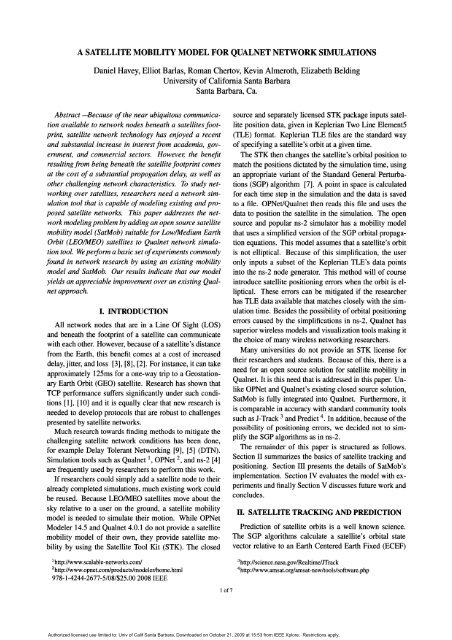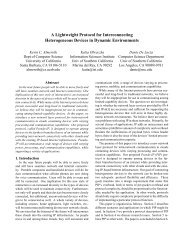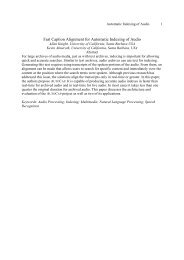A SATELLITE MOBILITY MODEL FOR QUALNET ... - NMSL
A SATELLITE MOBILITY MODEL FOR QUALNET ... - NMSL
A SATELLITE MOBILITY MODEL FOR QUALNET ... - NMSL
Create successful ePaper yourself
Turn your PDF publications into a flip-book with our unique Google optimized e-Paper software.
coordinate system. The latitude/longitude/altitude coordinatesystem used in Qualnet is an Earth Centered Inertial(ECI) coordinate system and thus a conversion must bedone. We accomplish this conversion by using an iterativealgorithm from the 200S Astronomical Almanac [6]. SatMob uses the Simplified General Perturbations SatelliteOrbit Model 4 (SGP4) from the SGP orbital propagationmodels introduced in SpaceTrack Number 3 report [7].The report contains 5 algorithms, SGP, SGP4/SDP4, andSGPS/SDPS. SGP was replaced by SGP4/SDP4 which arein standard use today. SGP4 is suitable for satellites orbitinga planetary body and SDP4 is suitable for deep spaceoperations. SGPS/SDPS attempt to account for orbital decayand re-entry, however, there is no evidence to suggestthat either has been implemented for operational TLE's.SatMob uses a variant of the Simplified General PerturbationsSatellite Orbit Model 4 (SGP4) developed byHoots et. al. SGP4 is a NASAINORAD algorithm forcalculating the orbital position of near Earth satellites (orbitalperiod of 225 minutes or less). SGP4 is adequatefor either Low Earth Orbit (LEO) or Medium Earth Orbit(MEO) satellites. Although, a mathematical treatment ofthis algorithm is beyond the scope of this paper, we willdetail the usage of our variant of SGP4.SGP4 is a standard model for spacecraft orbital predictionand its inputs are Keplerian elements in TLE format.TLE formatted files for in-flight satellites are availablefrom many sources including NASA 5 and AMSAT 6. Forin-flight satellite TLE data, elements that are more than30 days older/newer than the simulation time should beconsidered inaccurate because of perturbations in actualsatellite orbits.For given satellite simulations, researchers must generatetheir own sets of TLE formatted Keplerian elements.Keplerian data consists of seven and sometimes eight elements.The first seven satellite orbital elements are requiredto define a satellite's position relative to a positionon the ground and the eighth optional element defines thedrag that a planetary atmosphere places upon a satellite.Keplerian elements define an ellipse orientated about aplanetary body with the planet at the focus and the satellitesposition on the ellipse at a given time. The Keplerianmodel is slightly naive in that it assumes the ellipseis of constant shape and orientation. There are variantsof SGP4 that attempt to compensate for this inconsistencyby considering the unevenness ofthe planet's gravitationalfield and the drag placed on a satellite according to itsproximity to a planetary atmosphere. However, we didnot choose to use these methods as the gain in accuracywas not enough to justify the added complexity.The first element in a Keplerian TLE set is the Epochtime, the second and third elements are shown in Figure 15http://science.nasa.govlRealtime/jtrack/Satellitelinks.html6http://www.amsat.org/amsat-new/tools/keps.phpRight Ascension of the Ascending NodeOrbital InclinationObliqUity of the EclipticLine of NodesFig. 1. Orbital Diagram for Keplerian Elements 2 and 3.and describe a satellite's orbital plane. The next four elementsare shown in Figure 2 and describe a satellite'sposition in its orbital plane. The elements in a KeplerianTLE set are defined as follows:1. Epoch time: the Julian time at which a snapshot of Keplerianelements was taken. The epoch time is an absolutereference point in time. SGP4 calculates a satelliteslocation by propagating a satellite's orbital position forward/backwardfrom the epoch.2. Orbital inclination: the angle between the orbital planeof a satellite and the equatorial plane of a planet, its rangeis [0, ISO].3. Right Ascension of the Ascending Node (RAAN): theangle between the obliquity of the ecliptic and the placewhere the orbit of a satellite crosses the planetary equatorfrom the South to the North. The obliquity of the eclipticis the point where the orbit of the Sun, as seen froma planet crosses the Equator from the South to the Northon the vernal equinox. The RAAN gives us an absolutereference point in space. ECI coordinate systems such aslatitude/longitude/altitude cannot be used for this purposebecause of planetary rotation.4. Argument of Perigee: the angle between the Line ofNodes and the Line of Apsides. The Line of Nodes is theplace where the orbital plane of a satellite intersects withthe equatorial plane ofa planet. The Line ofApsides is theline passing through the major foci of a satellite's orbitalellipse, the center of a planet, and the perigee of a satellite'sorbit. The range of the Argument of Perigee is [0,360].5. Eccentricity: the shape of a satellite's orbital ellipse.Its range is [0, 1] with zero being a perfectly circular orbitand 1 being a highly elliptical orbit. The ratio of eccen-... ERatrlclty IS a == ~ where a is the distance between the2of7Authorized licensed use limited to: Univ of Calif Santa Barbara. Downloaded on October 21, 2009 at 15:53 from IEEE Xplore. Restrictions apply.
3BUSINESS OUTLOOK SURVEY | BANK OF CANADARESULTS OF THE SUMMER 2015 SURVEY | VOL. 12.2 | 6 JULY 2015At the same time, firms’ perception of U.S. economic growth is positive, and many, particularlymanufacturing firms, note that strengthening U.S. demand has translated into improved indicators offuture sales, such as advance orders and inquiries. Other businesses are still adjusting their strategies toexpand sales opportunities abroad. In this context, many firms reported that the lower Canadian dollaris a welcome development. Several exporters also cited a positive impact on sales volumes as a result.Following some softening in past sales growth, they expect stronger sales activity over the next 12 months.The balance of opinion on investment in machinery and equipment edged up from just above zero inthe previous quarter, pointing to an overall moderate increase in investment spending over the next12 months (Chart 3). The result masks a growing divergence across regions and sectors. In particular, plansto increase investment are more prevalent in Central Canada and in the manufacturing sector, where firmsgenerally benefit from a lower domestic currency and a positive U.S. outlook. Conversely, in light of weakoil prices, firms in energy-related regions and sectors plan to further curtail investment over the next12 months. Businesses holding back their investment plans cited reasons such as insufficient domestic andforeign demand for their products, as well as ample capacity.Chart 3: The balance of opinion on investment in machinery and equipment edged up but remains low…Balance of opinion aOver the next 12 months, is your firm’s investment spending on M&E expected to be higher, lower or the same as over the past 12 months?%403020100-10-20-302001 2003 2005 2007 2009 2011 2013 2015-40Higher: 36% Same: 36% Lower: 29%a. Percentage of firms expecting higher investment minus the percentage expecting lower investmentThe lower Canadian dollar is having an impact on firms’ investment intentions. Of the many businessesfacing higher costs for imported machinery and equipment, some indicate that they plan to restraininvestment as a result. On the upside, some of the exporters that are experiencing higher margins on theirU.S.-dollar-denominated sales reported that they plan to use the additional earnings to increase theirinvestment.The balance of opinion on employment remains below post-recession levels (Chart 4). It increased slightlyin the summer survey, however, as fewer firms plan to reduce staff. Hiring intentions improved in regionsless affected by energy prices, and businesses often cited expansion plans to meet strengthening demandfrom both domestic and foreign customers. In contrast, firms planning to reduce employment remainheavily concentrated in the oil-producing regions, where the low commodity-price environment isdampening demand. Other reasons raised for reducing staff include efficiency gains from, for example,automating processes.
have identified two avenues offuture work that need attention:satellite antenna pointing and footprint size. Thesefactors depend on an individual satellite's capabilities andmissions. These problems can be solved by collecting adatabase of infonnation for each satellite and importingthis data into Qualnet at initialization time as well as takingterrain into consideration.References[1] V. Cerf. The invisible internet. In Communications ofthe ACM,volume 44, pages 34-47. ACM, January 2001.[2] P. Chitre and F. Yegenoglu. Next-generation satellite networks:Architectures and implementation. In Proceedings ofIEEE CommunicationsMagazine, pages 30-36, March 1999.[3] G. Compareto and R. Ramirez. Trends in mobile satellite technology.In Proceedings of IEEE Computer, volume 30, pages44-52, 1997.[4] L. Breslau et ale Advances in network simulation. IEEE Computer,33(5):59-67, May 2000.[5] K. Fall. A delay-tolerant network architecture for challenged internets.In ACM SIGCOMM, pages 27-34, Karlsruhe, Germany,2003. ACM.[6] u.s. Government. The astronomical almanac. U.S. GovernmentPrinting Office, 2008.[7] R. Hoots, R.Roehrich, and T. Kelso. Spacetrack report #3: Modelsfor propagation of the norad element sets. U.S. Air ForceAerospace Defense Command, December 1980.[8] Y. Hu and V. Li. Satellite-based internet: a tutorial. In ProceedingsofIEEE Communications Magazine, pages 154-162, March2001.[9] S. Jain, K. Fall, and R. Patra. Routing in a delay tolerant network.InACM SIGCOMM, pages 145-158, USA, 2004. ACM.[10] L. Sanchez M. Allman, D. Glover. Enhancing tcp over satellitechannels using standard mechanism. RFC 2488, January 1999.VI. Reviewers Comments1. This paper describes a simplified model oflow orbitsatellite motion that can be integrated into <strong>QUALNET</strong>.The results have been validated against more accurateand computationly complex models and found to beaccurate. It promises to be an effective, low cost methodofincorporating LEOIMEO satellite motion in Qualnetmodel simulations.2. Excellent treatment ofsatellite orbital mechanics thepaper describes an open source satellite mobility model(SatMob)for LowlMedium Earth Orbit (LEOIMEO)satellites to be used as part ofexisting Qualnet networksimulation tools.3. This paper developed an open source satellite mobilitymodel for the Qualnet network simulator. contribution ofthis work allows users to easily add satellite nodes totheir network experiments without the purchase ofadditional software licenses such as the STK. The paperis very well written.70f7Authorized licensed use limited to: Univ of Calif Santa Barbara. Downloaded on October 21, 2009 at 15:53 from IEEE Xplore. Restrictions apply.




